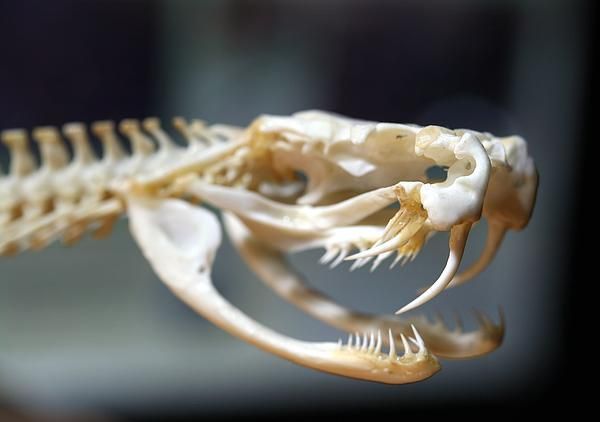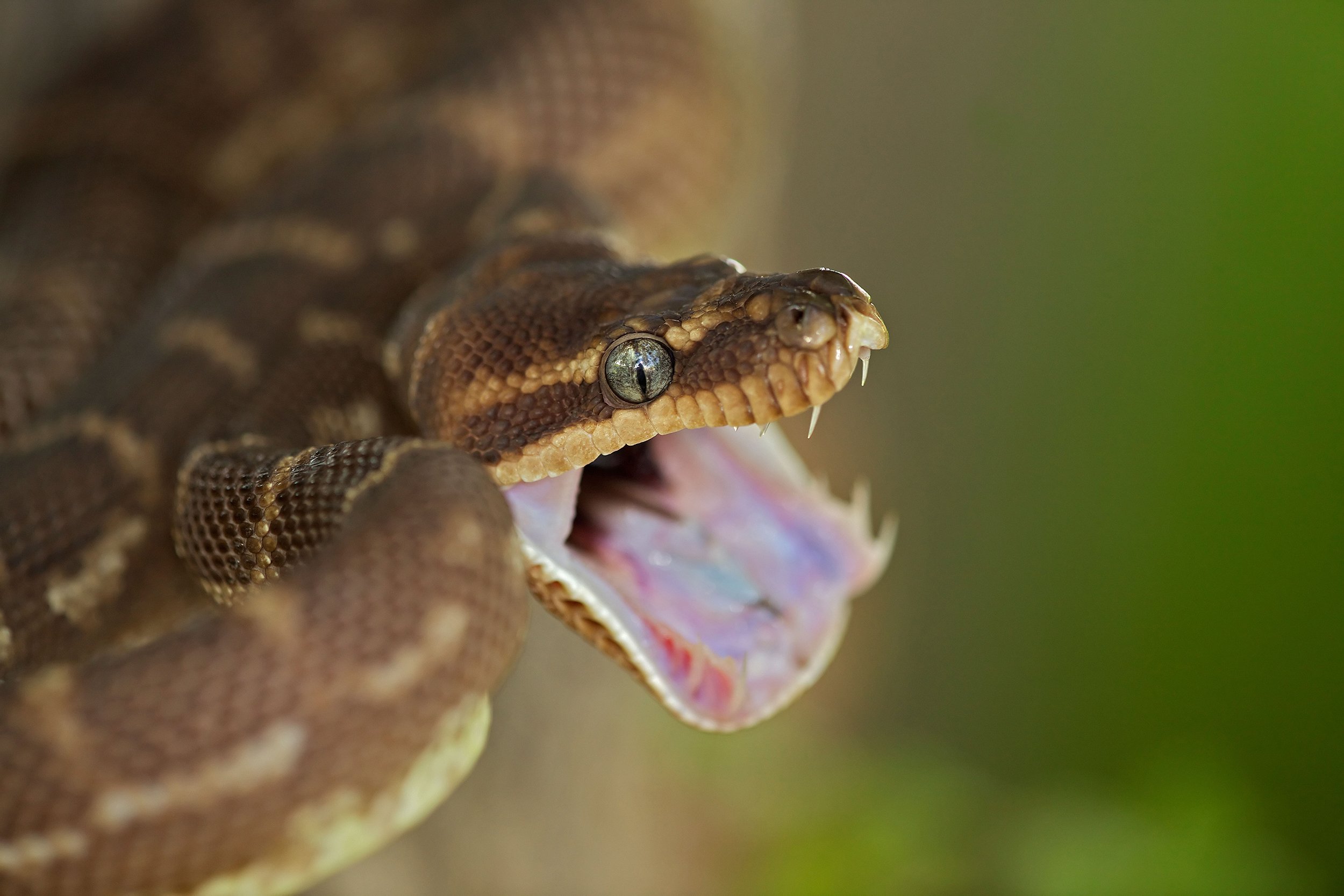Have you ever wondered, “Do snakes have teeth?” If so, then this blog post is for you. We’ll delve into the world of snake dentition, exploring how these fascinating creatures use their teeth not only for hunting but also as a defense mechanism.
You might be surprised to learn that all snakes have teeth – although they don’t use them in quite the same way we do! Join us on this informative and intriguing journey through various types of snake teeth and discover their unique purposes and functions.
Key Takeaways
- All snakes have teeth, but only venomous snakes possess fangs for injecting venom into their prey or adversaries.
- Snake teeth are not used for chewing but serve to grip and maneuver prey while swallowing whole. In some species, specialized fang-like structures may aid in subduing particularly large meals.
- Different snake species showcase unique tooth structures and placement depending on diet and hunting habits, providing valuable clues about their feeding preferences. Understanding the differences between tooth morphology can also assist in identifying potentially harmful encounters with venomous snakes.
- Venom delivery via fangs is crucial for survival among venomous snakes as it allows them to immobilize or kill their prey efficiently. The structure of snake fangs varies depending on the species, with some delivering enough venom to incapacitate or even kill humans.
Facts About Snake Teeth
All snakes have teeth, but not all snakes have fangs; teeth are not used for chewing, and fangs are used for defense, hunting, and venom injection.
All Snakes Have Teeth
One of the most fascinating aspects of snakes is their dental anatomy. Contrary to some misconceptions, all snakes possess teeth, regardless of whether they are venomous or not.
These teeth, known as aglyphous teeth, serve several purposes that aid in a snake’s survival and enable them to effectively navigate through its environment.
The presence and arrangement of these teeth provide crucial insights into the feeding habits and prey preferences among different snake species. For instance, constrictor snakes like pythons rely primarily on their sharp aglyphous teeth for grabbing onto prey before coiling around it tightly.
In contrast, venomous snakes utilize specialized fangs for immobilizing prey with venom before swallowing it whole.

Not All Snakes Have Fangs
Despite the common belief that all snakes have fangs, this is not entirely accurate. In reality, only venomous snakes possess these long, sharp, and hollow teeth specifically designed for injecting venom into their prey.
For example, non-venomous snakes such as corn snakes or garter snakes rely on small rows of recurved teeth to hold onto their prey rather than envenomating them with fangs.
These teeth are still effective but lack the ability to deliver venom.
Teeth Are Not Used For Chewing
Although it might seem surprising, a snake’s teeth serve no purpose when it comes to chewing food. Unlike most animals, snakes have no need to break down their prey into smaller pieces before consuming it.
Since snakes lack the ability to chew or grind their food, what role do their teeth play? Rather than being used for mastication like mammals’ teeth, a snake’s primary function of its teeth is gripping and maneuvering prey into position for swallowing.
This feat is accomplished thanks to multiple rows of sharp, backwards-facing teeth on both the upper and lower jaws; these small hooks effectively prevent the captured meal from escaping as it makes its way towards the snake’s stomach.
Fangs Are Used For Defense, Hunting, And Venom Injection
Snake fangs are not only a vital weapon in hunting, but also an important means of self-defense. Venomous snakes use their specialized teeth to inject venom into prey or adversaries.
For example, the black mamba snake’s long fangs can reach up to 6mm (0.25 inches) in length, making it one of the most dangerous snakes on Earth. Known for its incredibly fast strikes, the black mamba’s neurotoxic venom is powerful enough to kill a human within hours if left untreated.
Regardless of whether they use venom or not, all snake fangs serve an essential purpose: allowing these reptiles to survive and thrive in various environments around the world by providing crucial weaponry for hunting and defense against danger.
Types Of Snake Teeth
There are different types of snake teeth, including recurved and grooved. Understanding how these teeth function is crucial in explaining venom delivery and feeding habits.
Differences In Types And Placement
Not all snake teeth are created equal. Different species of snakes have varying types and placement of teeth, depending on their diet and hunting habits.
For example, rear-fanged snakes such as the boomslang have longer and curved fangs located at the back of their jaws, which they use to deliver venom into their prey’s bloodstream.
In addition to differences in fang morphology, some non-venomous snake species also possess specialized backwards-facing teeth located deep inside their throats known as “opisthoglyphs.” These unique structures help them grasp slippery or wriggling prey like fish and eels before swallowing them whole.
So next time you encounter a snake, take note of its tooth structure – it could provide valuable clues about what it likes to eat and how it hunts.
Importance Of Venom Delivery
Venom delivery is crucial for venomous snakes, as it allows them to immobilize or kill their prey. Without venom, a snake’s hunting effectiveness would be significantly reduced.
Venom also plays an important role in self-defense and protection against predators, as well as aiding in the digestion of prey. The structure of fangs varies depending on the snake species – some have long hollow fangs while others have shorter grooved fangs.
One example of how venom delivery plays a vital role in survival is seen in the black mamba, one of the deadliest snakes on earth. Its neurotoxic venom can paralyze and kill within minutes without prompt medical attention.
Another example is the boomslang snake which has rear-facing fangs which allow it to penetrate deep into its prey’s flesh when biting rather than merely trying to puncture skin like other forward-fanged snakes do.
How Snakes Use Their Teeth
Snakes use their teeth primarily for grasping and holding onto prey, but venomous snakes also use fangs to inject venom into their victims as a defense mechanism or to immobilize their food.
Feeding Habits
Snakes have a unique way of feeding that involves the use of their teeth. Here are some feeding habits of snakes:
- Snakes swallow their prey whole, using their teeth to grip and maneuver it into position.
- Some snakes have specialized teeth to help them capture their prey. For example, constrictors have small, curved teeth that help hold onto their prey while they wrap around them.
- Venomous snakes use their fangs to inject venom into their prey, which helps immobilize or kill it.
- Some snakes can eat prey that is much larger than themselves due to their ability to dislocate and expand their jaws.
- Snakes can go long periods without food since they have a slow metabolism.
Understanding snake feeding habits and the role of their teeth is crucial in helping us appreciate these unique creatures and stay safe around them.
Defense Mechanisms
Snakes have various defense mechanisms to protect themselves from predators. These include:
- Camouflage: Many snakes blend in with their surroundings to avoid detection.
- Warning signals: Some venomous snakes, such as the rattlesnake, use a rattle to warn predators of their presence and deter them from attacking.
- Mimicry: Non-venomous snakes can mimic the coloration and behavior of venomous species to discourage predators from attacking them.
- Feigning death: Some snakes will play dead when threatened, hoping that the predator will lose interest and move on.
- Escape: Snakes are fast, agile creatures and can quickly slither away from danger if they need to.
It is important to understand these defense mechanisms so that we can better appreciate and respect these fascinating creatures in their natural habitats.
Conclusion: The Importance Of Understanding Snake Teeth
In conclusion, understanding snake teeth is crucial for anyone who comes into contact with these reptiles. It helps to identify the venomous ones from the non-venomous species and avoid potential harm.
Snakes use their teeth primarily for hunting and defense purposes, which emphasizes the importance of respecting their space in nature and avoiding any confrontation with them when possible.
FAQs:
Do all snakes have teeth?
Yes, all species of snakes have teeth. However, the type and arrangement of their teeth varies depending on the species and their feeding habits.
How do snakes use their teeth?
Snakes primarily use their teeth for catching and holding prey, as well as defending themselves from predators or perceived threats. Some venomous snake species also use specialized fangs to deliver venom to their prey or attackers.
Are snake bites dangerous?
Yes, some snake bites can be extremely dangerous and even deadly if not treated promptly and properly. It’s important to seek medical attention immediately if you suspect you’ve been bitten by a snake.
Can snakes replace lost or damaged teeth?
Yes, many species of snakes are able to replace lost or damaged teeth throughout their lifetime through a process called dental replacement. This allows them to continue eating and hunting effectively despite tooth loss due to injury or wear over time.




